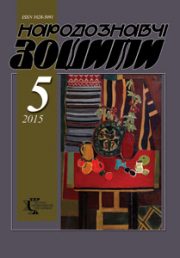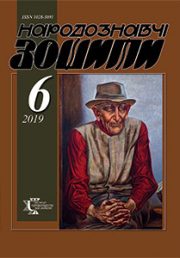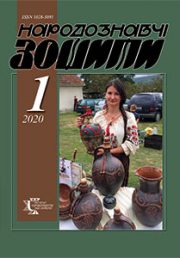The Ethnology Notebooks. 2025. № 3 (183), 625—630
UDK 930.2:[658.2:677.024-051=112.2]:334.722.24.012.42](477.41/.42-21)”18/19″
DOI https://doi.org/10.15407/nz2025.03.625
FACTORY CLOTH PRODUCTION IN KOROSTYSHIV (19th — early 20th century)
MOZGHOVENKO Olena
- ORCID ID: https://orcid.org/0009-0003-2403-4512
- PhD student at Ivan Franko Zhytomyr State University,
- 40, Velyka Berdychivska Street, 10008, Zhytomyr, Ukraine,
- Contacts: e-mail: tunik.mozghovenko.kraj@gmail.com
Abstract. The family-run manufactures of Prussian subjects in Korostyshiv filled a vacant niche in the weaving industry and, for a long time,they established a monopoly on the production of goods that were in considerable demand among the local population. German precision and meticulousness were reflected in the modernization and automation of production, transforming family manufactures into factories with hired workers. As a result, the cloth factory of the German manufacturer Robert Arnhold became the second most powerful in the Kyiv Governorate. With the development of production, the German cloth-makers faced competition from several Jewish industrialists who, depending on market demands, shifted their commercial focus, for example, from timber production to cloth manufacturing. This contrasted with the Germans, who regarded their activity as a family tradition. However, their strong positions were undermined by deportations on the eve of the First World War.
The relevance of the study lies in the fact that the German cloth manufactures provided a solid foundation for the Soviet authorities to establish and build a powerful cotton factory, which partially continued the German tradition of producing blankets. The purpose of the article is to examine the emergence, development, and significance of one of the light industry branches which is textile production in Korostyshiv in the 19th and early 20th centuries at the level of manufacturer-based enterprises.
The object of the study is cloth production within the Kyiv Governorate from the early 19th century to the early 1920s, and the subject is the manufactures of German cloth-makers, who were the sole large-scale producers of cloth.
Through the method of historicism, the settlement of German manufacturers in the town, the development of their manufactures, and their transition to factory-level production are depicted. Within the framework of the everyday life history approach, the sociological method is applied to reveal social issues closely related to the living conditions of Germans abroad and their influence on the development of family businesses. The study also employs methods of source study, systemic analysis, and interdisciplinary approaches. The geographical scope of the research includes the Zhytomyr and Kyiv regions.
Keywords: Germans, cloth-makers, Korostyshiv, cloth ma nu facture, Kyiv Governorate, weaving.
Received 4.06.2025
REFERENCES
- Hubytskyi, L. (2018). Trade in Kyiv Governorate (1793—1861): Monograph (P. 156). Kyiv [in Ukrainian].
- Ohloblin, O. (1942). German cloth factories in Korostyshiv. Nove ukrainske slovo, 215 (230), 3 [in Ukrainian].
- Karlina, O. (2015). Cloth production in the towns and townships of Volyn Governorate (late 18th — early 1860s). Istoriia Ukrainy, 5 [in Ukrainian].
- State Archive of Kyiv Region. (n. d.). Fond 2. Inventory 153. File 1 [in Ukrainian].
- State Archive of Kyiv Region. (n. d.). Fond 2. Inventory 1. File 10940[in Ukrainian].
- Funduklei, I. (1848). Military-statistical review of the Russian Empire. Kyiv Governorate (Vol. 10, part 1).Saint Petersburg [in Russian].
- Central State Historical Archive of Ukraine in Kyiv. (n. d.). Fond 127. Inventory 1009. File 51 [in Ukrainian].
- National Digital Archive. (2022, September). Retrieved from: https://www.nac.gov.pl [in Polish].
- Zapasko, Ya. (Ed.). (2000). Decorative and applied arts: Dictionary (Vol. 1). Lviv: Afisha [in Ukrainian].
- State Archive of Kyiv Region. Fond 1. Inventory 231. File 97 [in Ukrainian].
- Central State Historical Archive of Ukraine in Kyiv. (n. d.). Fond 574. Inventory 1. File 1020 [in Ukrainian].
- Varzar, V. (Ed.). (1912). List of factories and plants of the Russian Empire: Compiled from official data of the Department of Industry of the Ministry of Trade and Industry. Saint Petersburg [in Russian].
- State Archive of Kyiv Region. (n. d.). Fond 1. Inventory 250. File 44 [in Ukrainian].







